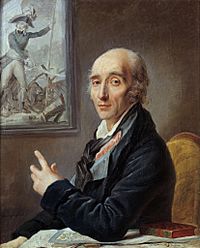Charles-Pierre Augereau facts for kids
Quick facts for kids
Marshal of the Empire
Charles-Pierre-François Augereau
Duke of Castiglione
|
|
|---|---|

Portrait by Robert Lefèvre (1805)
|
|
| Born | 21 October 1757 Paris, France |
| Died | 12 June 1816 (aged 58) La Houssaye-en-Brie, France |
| Buried |
Père Lachaise Cemetery
|
| Allegiance | |
| Service/ |
Army |
| Years of service | 1774–1815 |
| Rank | Marshal of the Empire |
| Battles/wars | French Revolutionary Wars, Napoleonic Wars Battle of Loano Battle of Millesimo Battle of Castiglione Third Siege of Gerona |
| Awards | Grand Officer of the Legion of Honour Grand Cross of the Order of Charles III of Spain Knight of the Order of Saint Louis Peer of France |
| Signature | |
Charles Pierre François Augereau (born October 21, 1757 – died June 12, 1816) was a famous French military leader. He became a Marshal of the Empire, which was a very high rank in the French army. He fought in two major conflicts: the French Revolutionary Wars and the Napoleonic Wars.
Augereau quickly rose through the ranks. He became a division commander under Napoleon Bonaparte in Italy. He fought bravely in many of Napoleon's early battles. Later, Napoleon gave him important commands during the Napoleonic Wars. Napoleon himself said that Augereau had "plenty of character, courage, firmness, activity" and was "well liked by the soldiery." Many people consider Augereau one of the best generals of his time.
Contents
Early Life and Military Beginnings
Charles Augereau was born in Paris, France. His father was a fruit seller. When he was 17, Augereau joined the army. He was known as a skilled swordsman and often got into duels.
After some trouble, he left France and traveled across Europe for 13 years. He claimed to have served in the Russian Army and even in the Prussian Foot Guards. He later returned to France in 1781. He joined the cavalry and was sent on a military mission to Naples.
While in Naples, he met Gabrielle Grach. They went to Portugal together. When the French Revolution started, Portuguese authorities arrested Augereau. Luckily, Gabrielle helped him get released, and they returned to France. In 1792, he joined a volunteer cavalry unit.
Rising Through the Ranks in the Revolutionary Wars
Augereau's military career really took off during the French Revolutionary Wars. In 1793, he became a general of division. He was part of the Army of the Eastern Pyrenees.
He played a key role in the Battle of Boulou in 1794. His clever attacks tricked the Spanish army. After this victory, his army advanced into Spain. At the Battle of San-Lorenzo de la Muga, he successfully defended against a larger Spanish force. He also helped win the Battle of the Black Mountain.
After the war with Spain ended, Augereau and his troops moved to the Army of Italy. Here, he began working closely with Napoleon Bonaparte. He fought in many important battles in 1796, including the Battle of Millesimo and the Battle of Borghetto.
His most famous moment was at the Battle of Castiglione in August 1796. Augereau's bravery was crucial. He held off a large Austrian army with his 11,000 men. This allowed Napoleon to gather his main forces and win a major victory two days later. This battle was so important that Augereau was later given the title "Duke of Castiglione."
In 1797, Napoleon sent Augereau to Paris. He helped Napoleon gain more power in the French government. Later, in 1804, when Napoleon became Emperor, Augereau was made a Marshal of the Empire. This was a great honor.
Augereau in the Napoleonic Wars
As a Marshal, Augereau commanded the VII Corps of Napoleon's Grande Armée. He helped protect the army's supply lines during the Ulm campaign in 1805. He also fought in battles like Konstanz and Bregenz. His troops defeated an Austrian division at Dornbirn.
During the War of the Fourth Coalition, Augereau led his corps at the Battle of Jena in 1806. His troops formed the left side of the French army. In 1807, he became ill with a fever. Even so, he bravely led his corps at the Battle of Eylau. He was wounded in the arm during this battle.
In 1808, he became the Duke of Castiglione. This was a special title given to honor his victory in 1796. In 1809, he married Adélaïde Josephine Bourlon de Chavange. They did not have children.
Augereau also served in Spain during the Peninsular War from 1809 to 1810. He achieved some successes there. He did not take part in the Russian campaign in 1812. He was also ill during the German campaign in 1813.
Before the Battle of Leipzig in October 1813, Napoleon challenged him. Napoleon said he wasn't the same Augereau from Castiglione. Augereau replied, "Give me back the old soldiers of Italy, and I will show you that I am." He still led his troops well at Leipzig.
In 1814, Augereau was given command of the army in Lyon. After Napoleon's first defeat, Augereau supported King Louis XVIII of France. However, when Napoleon returned for the Hundred Days, Augereau switched sides again. Napoleon, though, did not trust him this time.
After Napoleon's final defeat in 1815, King Louis XVIII returned to power. Augereau lost his military title and pension. He died a year later in 1816 at his home. He is buried in the Père Lachaise Cemetery in Paris.
Images for kids
See also
 In Spanish: Pierre François Charles Augereau para niños
In Spanish: Pierre François Charles Augereau para niños




